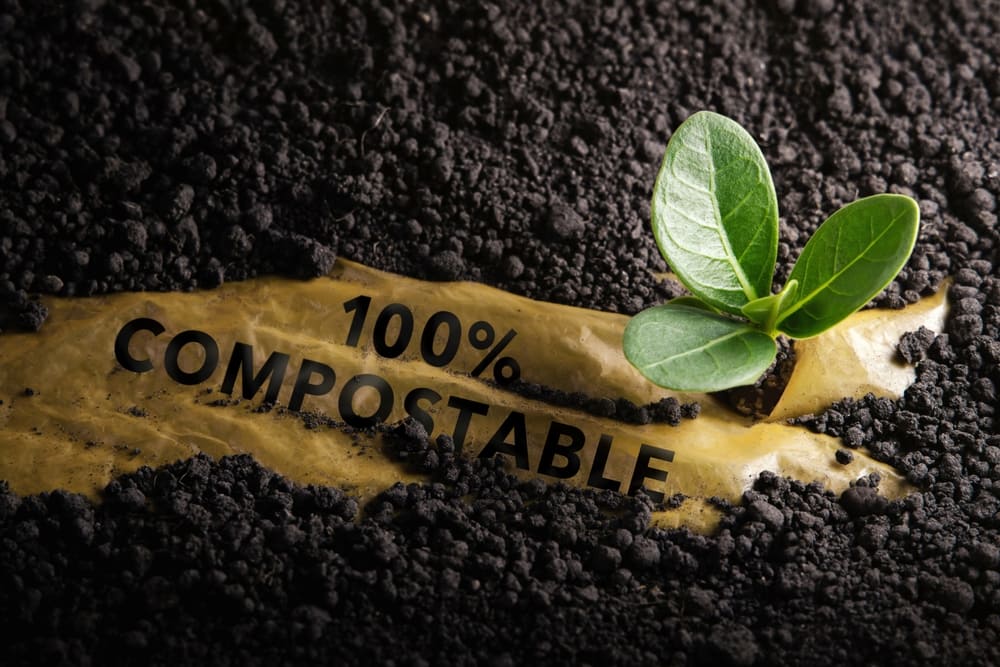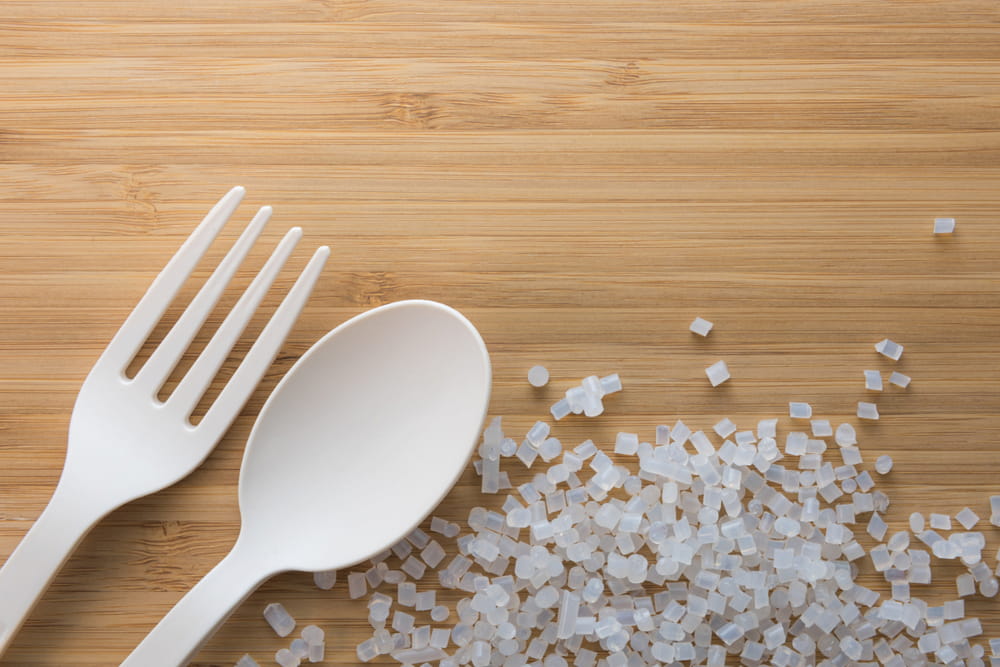Understanding Compostable Plastic: A Sustainable Alternative
08 Apr 2025
The rise of compostable plastic is a significant breakthrough in the plastic industry, offering a sustainable alternative to conventional plastics. These materials help improve waste management efficiency, promote an effective circular economy, and reduce environmental impact.

Bioplastics and Compostable Plastics: Understanding the Differences
1.1 What Are Bioplastics?
Bioplastics, with their special properties, provide more sustainable alternatives to traditional plastics. They are classified into three main groups:
1. Bioplastics made from renewable resources but not biodegradable/ Compostable
These bioplastics are produced from renewable natural materials such as cassava starch, sugarcane, and corn. Examples include Bio-PE and Bio-PET, which help reduce greenhouse gas emissions compared to petroleum-based plastics but do not naturally decompose.
2. Biodegradable bioplastics that may be derived from petroleum
Microorganisms can break down the molecular structures of some biodegradable bioplastics, such as PBAT and PCL, even though these bioplastics are sourced through fossil fuels.
3. Bioplastics that are both bio-based and biodegradable/ Compostable
The most environmentally friendly option, such as PLA, Bio PBS contributes to reducing fossil fuel dependency and persistent plastic waste accumulation.
1.2 What Is Compostable Plastic?
Compostable plastic, a type of bioplastic, is designed for complete decomposition in specific environments with the right levels of moisture, temperature, and microbial activity.Examples include PLA, PBS, PBAT, and PHA.
To be classified as compostable plastic, it must fulfill the following criteria:
- Fully decomposes under optimal composting conditions, requiring adequate moisture, temperature, and microorganisms.
- Complies with established standards such as TIS 17088, which defines testing conditions and decomposition timeframes.
- Does not leave behind microplastics or toxic residues, unlike OXO-degradable plastics, which only break into smaller fragments rather than disintegrating entirely.
- Breaks down into water, carbon dioxide, and biomass, making it safe for the environment through microbial degradation.
The Difference Between Truly Biodegradable Plastics and Misleading Claims
To help consumers make informed choices about environmentally friendly products, it’s important to recognize that marketing terms can sometimes be misleading. Many products claim to be “biodegradable”, but their actual properties and environmental impact vary significantly. One example is OXO-degradable plastics, which do not fully decompose but instead break into smaller fragments.
This following information clarifies the risks of using uncertified or deceptively marketed plastics, so consumers can choose environmentally beneficial materials.
2. The Dangers of OXO-Degradable Plastics and Microplastics
OXO-degradable plastics, while containing chemicals to speed up their breakdown, don’t completely biodegrade. Instead, they fragment into smaller pieces, ultimately becoming microplastics that remain in the environment without fully decomposing.
Impact of Microplastics
- Environmental contamination: Microplastics’ small size and resistance to conventional filtering techniques pose a significant challenge for waste management.
- Threats to marine life: Aquatic animals often ingest microplastics, mistaking them for food.
- Health risks: Microplastic exposure has been shown to disrupt respiratory, digestive, and reproductive systems across various species.
- Entry into the human food chain: Concerns about long-term health are rising due to microplastics entering the human food chain through contamination of seafood, drinking water, and the air.
3. How Are Bioplastics Composted? Decomposition Mechanisms and Standards
Biodegradation is a natural process where microorganisms break down organic materials into carbon dioxide, water, and humus.
Factors Affecting the Rate of Biodegradation
For effective bioplastic decomposition via composting, particular environmental factors are required. The key factors influencing the speed and efficiency of degradation include:
- Material composition: The speed at which a plastic degrades depends on its chemical structure and molecular complexity.
- Environmental conditions: Heat, moisture, and microbial activity all play a significant role in the composting process.
Important Standards for Biodegradable Plastics
Many countries set standards for compostable plastic to guarantee that they truly biodegrade within acceptable timeframes and safely.
Key standards include:
- Thailand: TIS 17088-2562 – certification for industrial composting processes.
- United States: ASTM D6400 – standard for compostable plastic in industrial composting facilities.
- Europe: EN 13432 – biodegradability certification for compostable materials.
- Australia: AS 4736 – certification for compostable and biodegradable plastics.

4. Choosing and Properly Disposing of Compostable Plastic
Appropriate Applications
Compostable plastic is suitable for producing:
- Single-use food packaging, includes cups, plates, cutlery, and straws.
- Organic waste bags that can decompose along with food scraps.
- Products with a high risk of environmental leakage, where compost reduces long-term pollution.
Proper Disposal Methods
To ensure compostable plastic breaks down effectively, it should be disposed of with other organic waste. The two primary composting methods include:
- Industrial Composting: Requires a temperature of at least 58°C and 90% relative humidity, taking approximately six months to fully degrade.
- Home Composting: Suitable for lower temperatures (25°C) with 50-60% humidity, typically taking around 12 months for decomposition.
Certification and Labeling
Certification and labeling help consumers identify genuine compostable plastic products, improving waste sorting and preventing greenwashing—misleading environmental claims.
Recognized certification labels include:
- DIN CERTCO (Germany): A globally recognized, strict compost standard.
- Biodegradable Products Institute (BPI) (United States): Certifies compostable products in North America.
- Thailand Bioplastics Industry Association (TBIA) (Thailand): Ensures compliance with national compost standards.
- GC Compostable Label: Indicates products or packaging made from compostable plastics developed or certified by GC Group.
5. Challenges and Sustainable Development
While compostable plastic offers innovation and benefits, widespread sustainability needs further advancements to address key challenges. This technology’s benefits are best maximized through collaboration between industries, governments, and consumers.
Current Challenges
Despite its advantages, bioplastics face several obstacles that need to be systematically addressed, including:
- Consumer confusion: Many consumers lack a clear understanding of the differences between various types of plastic, leading to incorrect disposal or misuse.
- Regulatory gaps: Clear, enforceable regulations for labeling and classifying biodegradable plastics are absent in some countries.
- Greenwashing concerns: Certain companies misrepresent their products as eco-friendly without meeting proper compost standards.
5 Key Principles for Effective and Sustainable Plastic Use
Achieving sustainability in plastic consumption requires a comprehensive and strategic approach at individual, business, and policy levels. These five principles can help guide responsible plastic usage:
- Reduce – The best way to minimize waste is by reducing unnecessary plastic consumption, especially single-use plastics. Choosing products with minimal packaging or bringing reusable containers when shopping helps cut waste at the source.
- Renewable – Supporting industries that use renewable, plant-based raw materials instead of fossil-based plastics can significantly reduce greenhouse gas emissions while boosting the agricultural sector.
- Reuse – Designing durable, long-lasting products that can be reused multiple times instead of disposable alternatives helps conserve resources and reduce
- Recycle – Developing efficient waste management systems and designing plastics that are easy to recycle (without mixing incompatible materials) ensures valuable resources are repurposed instead of ending up in landfills.
- Compostable – Using compostable plastic for products that are difficult to recycle or prone to environmental leakage, such as organic waste bags and food-contaminated packaging, helps minimize long-term pollution.
6. GC’s Innovations in Compostable Bioplastics
Eco-Friendly Bioplastic Production Technology
GC employs cutting-edge technology to develop compostable plastic, using plant-based raw materials sourced from locally grown cassava and sugarcane in Thailand. This approach supports Thai farmers, reduces dependence on fossil fuels, and helps lower greenhouse gas emissions.
Innovative Products for Various Applications
GC’s compostable plastic solutions cater to diverse applications, including food packaging (cups, plates, cutlery, and containers), organic waste bags that break down with food scraps, consumer goods packaging, and various household and industrial products.
Reducing Environmental Impact Throughout the Product Life Cycle
GC conducts Life Cycle Assessments (LCA) to evaluate the environmental footprint of its bioplastics. Research shows that GC’s compostable plastic reduces greenhouse gas emissions by more than 50% compared to conventional plastics.
The development of compostable plastic plays a vital role in addressing plastic waste issues. When combined with responsible plastic consumption and sustainable waste management practices, it significantly reduces environmental impact. To ensure genuine environmental benefit, choosing certified and standardized composting plastic products is essential.
As a leading bioplastics manufacturer in Thailand, GC is committed to producing high-quality compostable plastic to help reduce plastic waste and minimize ecological harm. If you are interested in GC’s bioplastic products or require more information, please fill out the inquiry form, and a GC representative will contact you.
References:
- พลาสติกย่อยสลายได้ทางชีวภาพ. Retrieved on March 10, 2025 from, https://www.mtec.or.th/bio-plastic/plastics-degradation/biodegradable-plastic.html
- พลาสติกย่อยสลายได้ทางชีวภาพ. Retrieved on March 10, 2025, from http://otop.dss.go.th/index.php/en/knowledge/informationrepack/394-biodegradable-plastics?showall=1&limitstart=

